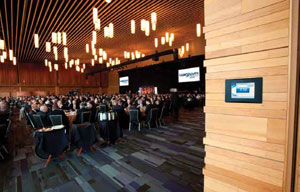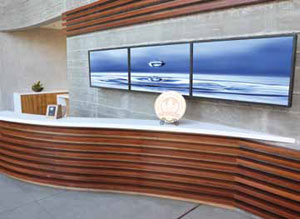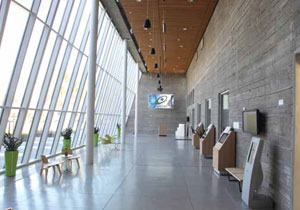Go Beyond the Room with Whole Building Automation
Across the board from smaller-scale projects to large campus installations, including ones in between like The Frontier Project facility, the LEED benefits promoted by building automation provides a calculable ROI for clients.
Whether for a new construction project or a retrofit, building automation can offer the owner or operator a return on investment in just a few years through significant reductions in energy costs and increases in productivity. Building automation also offers an opportunity for AV specialists to grow their businesses—yet many are leaving money on the table.
David Wilts, director of integrated building technology (IBT), Crestron Electronics, observed that automation is always easier to include in a new construction project. “You already have a complete design team together. You can work with this design team to coordinate everything with the electrical requirements, tying into the building management and automation. And there are contractors who are ready and waiting to implement whatever the design team comes up with.”
After the “first cost” of implementing everything in a new building, the focus shifts to the lifecycle costs. “That lifecycle cost is where the savings are looked for to derive your return on investment,” said Wilts.
If the design team is looking to implement cutting-edge technologies, “You can really look at ways to reduce labor costs, material costs, and project time. Those savings are usually more than enough to pay for the smarter technologies. As far as the owner or developer is concerned it’s still the same first cost to them but they’ll be able to experience those lifecycle savings from day one.”
Offering a simple example in being smart, he continued, consider a lighting control occupancy sensor in a conference room: “That’s a waste of money. That status should be shared amongst all of the systems.”
Or, run a single low-voltage line from a controller instead of multiple high-voltage lines through conduit to light switches. An IBEW licensed electrician charges $88 an hour, said Wilts. By reducing such costs “you can start implementing smarter systems for the same first cost, and show greatly increased value for that same first cost.”
A different approach is required on a retrofit, he continued. The best first step is to monitor building energy costs or, ideally, separate circuit breakers, to isolate the energy costs associated with each system. That will identify the best ROI for capital improvements. Implement solutions in one area—for example, mechanical—and take the money saved there and start applying it to lighting, and so on.
“You can go through each of the building’s systems and over, say, a three- to five-year process upgrade everything with no increased costs to the owner or developer. But once you’re done they’ll see anywhere between a 15 and 50 percent drop in their costs of energy.”
Crestron is getting a lot of traction with these approaches, according to Wilts. Yet others are not necessarily taking this holistic approach. “What the AV industry needs to do is wake up and start doing lighting control. It’s a huge opportunity where AV just needs to man up, to be blunt, and start taking control of the situation.
“There’s a ton of work out there and a ton of scope that could be sold that is sitting there waiting. You’re not going to see electrical contractors get into this type of complex automation. It’s not that you’re stealing scope off the electrical contractors; you can use their guys to install it, then everybody’s happy.”
Gerard Darville, product marketing manager, Lutron Electronics, couldn’t agree more. As the company’s former commercial AV manager, he said, “I remember calling on all these AV dealers and very few seized the opportunity to do more than just AV.”

“What the AV industry needs to do is wake up and start doing lighting control. It’s a huge opportunity where AV just needs to man up, to be blunt, and start taking control of the situation,” said Crestron’s David Wilts.
Energy prices are unlikely to decrease any time soon, he pointed out. Energy-saving technology installed as part of the AV system might be applicable to other systems, so start a conversation with the building operator, he suggested: “By the way, do you know I’m saving you energy in this space? I can scale this very easily to your whole building.”
There are few technological barriers to expanding the project scope beyond one conference room or one floor, or beyond the integrator’s specialty. “Traditionally, people looking at BMS [building management system] or BSS [building support systems] for huge buildings had to plan for it from the beginning. But with the advent of wireless technology and more intelligent DSP controllers, many people can attack the space.”
The technology is available, Darville pointed out: “Wireless systems, wireless sensors, occupancy sensors, wall stations, a move towards digital fixtures; it just becomes a question of who can set the system up better or quicker or convince the guy they can support it better. I see real opportunity, for everybody. But somebody has to bring the conversation up first.”
And, as Darville stressed, “AV guys do touch many aspects of the building.”
Kendra Philips, business development and marketing manager with California-based AV and communications systems integration company Spinitar, is well aware of the gambit. “It’s become the lead-in item for us, being able to tie-in to the building automation. It allows us to gain control of the project and get involved earlier. It’s not just specific to the audiovisual; we’re the universal remote for all buildings—and not everybody has that capability.”
Many of Spinitar’s larger clients are striving for LEE D (Leadership in Energy and Design) certification, reported Philips. “Green is the goal. But even with smaller-scale clients who are talking about one or two boardrooms, energy management is such an important topic for people these days.”
It’s an easily calculated ROI, she observed, and easier to justify in larger buildings where the costs are higher. “And when you’re looking at most boardrooms, control is a necessity anyway. So the cost of tying into the lighting and the shades is minimal.”
California’s building codes and standards are pretty progressive, she continued. “Whether or not you go through the process of submitting your paperwork to get LEE D, you’re still at the LEE D standard. But a lot of our clients are working towards Gold or Platinum standards.”

Building automation allows AV integrators to gain control of the project and get involved earlier, said Kendra Philips at Spinitar: “It’s not just specific to the audiovisual; we’re the universal remote for all buildings—and not everybody has that capability.”
The question is where Spinitar, as an AV specialist, plays into this, she said. “For us, it’s videoconferencing and control where we can provide a huge value and play a part in the green movement.”
While it might often be very difficult to pry the corporate coffers open, especially in today’s cost-conscious atmosphere, building operators are coming to recognize that ROI comes back in a couple of ways, said Steven Emspak, a partner at acoustics, audio-visual and technology consulting firm Shen Milsom & Wilke. “Obviously in dollars saved, but to some extent a truly integrated building management system saves lives,” he pointed out. “If you are really integrating all the services in the building you can really control the flow of people in an efficient way.”
Look at illuminated exit signs, for example, he said. “Those are fine in a static environment but if you’re in a dynamic environment, put your digital signage to work. Get them pointing in the direction you need them to point.”
In Emspak’s experience, “The larger environments are more apt to be interested in spending the necessary money. And new construction is more apt to accommodate it, if for no other reason than that there’s more of a tendency today for a better integration of systems to begin with.”
But there are certain technical barriers to a total integration of building automation systems, he considered. “You’ve got all these disparate systems—elevator control, HVAC, fire alarm, security cameras, door releases, digital signage, a million different subsystems— and stitching those together is probably the big issue. It’s that software overlay, and the willingness of the HVAC guy and the elevator guy to allow you into their code to control it.”
Nobody is thinking much about integration, he said. “Even at that level they don’t see an ROI; they’re focused on selling their own products versus the competition. Their level of interest is probably a lot less in providing hooks and APIs to provide some sort of cross-platform integration from a control standpoint.”
As design consultants, Shen Milsom & Wilke is moving in the right direction with the different disciplines to bring them together, Emspak said. “The ability to get all these lowvoltage systems on a common backbone and run it through a building or a campus—that’s the root issue.”
Whether control protocols and standards can be developed remains to be seen. As Lutron’s Darville noted, there are pros and cons to standardization. “The pro is that theoretically they can be installed and commissioned by everybody. The con is that a lot of people can potentially screw it up.”
And who would shoulder the ultimate responsibility in such a situation? “As an owner I would like to be able quickly to call somebody for my life safety systems; I’m there to make people productive, so I can’t have any downtime.”
Steve Harvey (psnpost@nbmedia.com) has been west coast editor for Pro Sound News since 2000.
Automation STEPs
David Wilts of Crestron Electronics, a LEED accredited professional, is chair of InfoComm’s IBT Task Force and sits on the InfoComm STEP Sustainability Rating System Committee and the BIM Best Practices Task Force.
STEP—Sustainable Technology Environment Program—is a complement to LEED that rates electronic systems. “About a third of the credits are focused on getting systems to be integrated, leveraging automation and scheduling applications, as well as really reducing energy consumption,” explained Wilts.
The groups are working to empower AV consultants, dealers, and programmers to grow their businesses and leverage integrated building technology, he said. Taking an innovative approach, the IBT Task Force is comprised of both AV industry and design and construction industry people.
“We’re really going to be assessing what are the barriers to deploying automation and integrated building technology. We’ll be focused on finding solutions to those barriers that we’ll then be able to share with the AV industry.”
—S.H.
Automated Tour
The Cucamonga Valley Water District (CVWD) of Rancho Cucamonga, CA built The Frontier Project facility to educate the surrounding community about sustainable building practices. In order to effectively communicate the various sustainable features of the facility, the CVWD turned to Spinitar to design and integrate a series of audiovisual systems that could provide a self-guided interactive learning experience.
Spinitar took a whole-building automation approach to its AV design, with solutions deployed from reception, through an exhibit hall, combinable conference rooms, all the way to the facility’s kitchen. The Frontier Project’s AV system disseminates real-time building performance information in a format that students, local residents, and industry professionals can understand. The AV systems not only track building performance, but also provide visitors with the opportunity to learn about commercial and residential sustainable building features as well as products and service providers.
Inside the space, there are several areas where AV is a prominent feature. Among these is the Exhibition Hall, which provides visitors with information pertaining to The Frontier Project and the sustainable practices used to build the LEED Platinum Facility. Two 26-inch ELO touch screen displays mounted in a custom-designed kiosk deliver interactive information on the AV housed in the equipment room. They are also used to guide individuals through tutorials.
On both sides of the equipment room there are two 42-inch Mitsubishi LCDs that are wall mounted and used to run The Frontier Project Information content. Audio and video content for events in the hall is provided by 15 SoundTube pendant-mount ceiling speakers, a Christie LCD projector, and a 133-foot diagonal Draper acrylic screen.
AMX is featured throughout The Frontier Project, and in the kitchen the control system is tied into the lighting system, enabling the system to spotlight individual Green/Energy Star compliant appliances as they are discussed in a tutorial.
The building’s combinable conference rooms are equipped with a Polycom multi-point video conferencing unit. The system can be used by the public and surrounding businesses, with the goal of encouraging them to reduce their carbon footprint by using the technology. In addition, this space’s Accordent rich media recording system acts as a revenue source for The Frontier Project. It allows local organizations, businesses, and learning facilities to host seminars and monthly meetings that are recorded and offered as a file that can then be uploaded to their website for public viewing.
